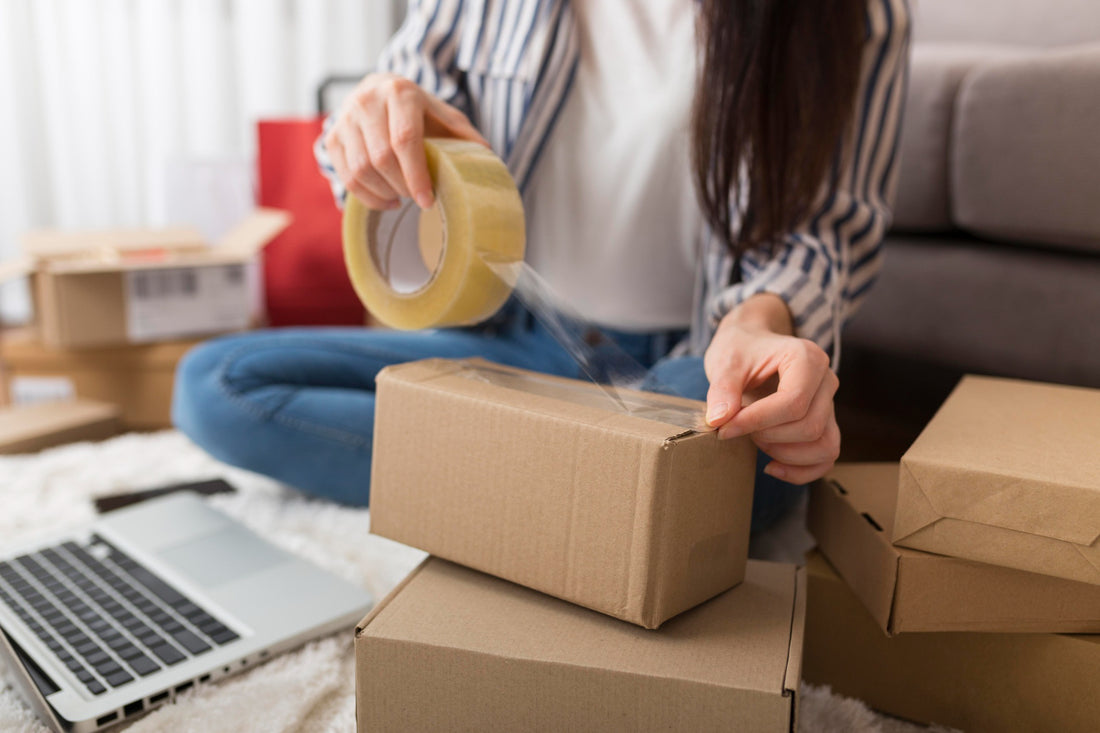In the modern world, electronics are a crucial part of our daily lives. They are used for entertainment, communication, work, education, and more. However, packing and moving electronics can be challenging as they are expensive, delicate, and fragile items that can easily get damaged or lost during transit. To ensure their safety and functionality, following some best practices when packing and moving electronics is important.
The guide will provide expert tips on how to pack and move electronics safely like a pro. We have over eight years of experience in the removal industry and years of experience selling packaging for moving and shipping so that you can trust our advice. We will cover the following topics:
#1. Preparing Electronics for Packing and Moving
#2. Choosing the Right Packing Materials and Boxes
#3. Packing Electronics Securely and Safely
#4. Labeling and Organizing Electronic Boxes
#5. Transporting and Storing Boxes Properly
#1. Preparing Electronics for Packing and Moving

Before packing electronics, some preparation work must be done to avoid any potential problems or complications later. Here are some steps that you should take:
1. Back up data. Backing up the data from your devices, such as computers, laptops, tablets, and smartphones, is crucial to avoid losing important files, photos, videos, or documents during the move. You can use external hard drives, cloud storage, or online backup services. Doing so can ensure your valuable data is safe and secure, even if something unexpected happens to your devices.
2. Disconnect and unplug devices. You should disconnect and unplug devices from the power sources, cables, wires, and accessories. It will prevent any electric shocks, short circuits, or fire hazards. Remove any batteries, cartridges, or discs from devices, as they can leak or explode due to temperature changes or pressure.
3. Clean devices. Clean devices with a soft cloth, a microfiber cloth, or a compressed air duster. It will remove any dust, dirt, or debris that can damage devices or affect their performance. Wiping screens with a screen cleaner or a mild solution of water and vinegar can help avoid scratches or smudges.
4. Take photos and inventory. Taking pictures of devices and their settings, configurations, and connections can help you remember how to set them up and reconnect them after the move. Making an inventory of devices and their accessories, such as cords, chargers, adapters, remotes, manuals, etc., can help keep track of everything and remember everything.
#2. Choosing the Right Packing Materials and Boxes
Choosing suitable packing materials and boxes for electronics is crucial. High-quality, durable materials should protect devices from shocks, impacts, or vibrations. Here are some materials and containers that should be used:
1. Heavy-duty, double-walled cardboard boxes. These boxes are the best option for packing and moving electronics as they are much more robust and reliable than single-walled boxes. They can hold a heavier weight without breaking, which is especially useful for heavy electronics. Double-walled boxes can protect the contents better and withstand any knocks or bumps during transit. They are better for stacking on top of one another without collapsing, saving space and ensuring that electronics are kept safe no matter where they are in the pile.
2. Bubble wrap and tissue paper. These are the best materials for wrapping and cushioning electronics before packing them. Use enough bubble wrap and tissue paper layers to cover devices entirely and securely. Bubble wrap and tissue paper will create a protective layer around devices, absorbing any shocks or impacts that may occur during the move. They will also prevent scratches, dents, or cracks on devices. Bubble wrap is also waterproof, protecting electronics from water damage if it rains during transit.
3. Packing peanuts and foam. These are the best materials for filling gaps or spaces inside boxes. Enough packing peanuts and foam should fill boxes tightly and snugly, leaving no room for devices to move around or shift within the box. Packing peanuts and foam will provide extra cushioning and device support, preventing damage or breakage. They will also keep boxes balanced and stable, avoiding tipping or falling.
4. Strong packing tape. The best material for sealing and securing boxes shut. Enough strong packing tape should be used to close boxes firmly and securely so they do not split open or apart during transit. Only adhesive solid tape that is 48mm wide should be used. Standard tape from a supermarket is not strong enough and may peel off or tear easily.
5. Cling film or stretch wrap. An optional material that can be used to wrap boxes after packing them. It protects extra boxes, especially from water damage, dust, dirt, or insects. Cling film or stretch wrap will keep containers tightly sealed and secure, preventing tampering or theft.
#3. Packing Electronics Securely and Safely
Now that the electronics have been prepared and suitable packing materials and boxes have been chosen, it is time to pack electronics securely and safely. Here are some tips and tricks to follow:1. Choose the correct box size. A box that is the right size for the device, allowing for a small space for protective packaging, should be used. If a box is too large, there will be too much excess space inside the box, which can cause the device to move around or shift within the box, causing damage. If a box is too small, the device will not fit into the box. The device should be measured, and the dimensions of the box should be compared before buying it. The original boxes that the devices came in can also be used as they are usually the perfect size and shape for them. However, they should still be used with protective packaging inside as they may need to be stronger or in better condition to protect devices adequately.
2. Wrap devices individually. Each device should be wrapped separately with bubble wrap and tissue paper, covering them completely and securely. The bubble wrap and tissue paper should be taped so they do not come off or loosen during the move. Multiple devices should not be wrapped together as they may rub against each other or cause pressure on each other, resulting in damage. Newspapers or magazines should not be used to cover devices as they may leave ink stains or marks.
3. Pack accessories separately. Accessories such as cords, chargers, adapters, remotes, manuals, etc., should be packed individually from devices. Each accessory should be wrapped with bubble wrap and tissue paper and put in a small ziplock bag or box. Each bag or box should be labeled with the name of the device it belongs to so you can easily find and match them later. Accessories should be kept from being packed with devices as they may get tangled, lost, or damaged. Accessories should also not be packed loosely in the box as they may move around or shift within the box, causing damage to devices or themselves.
4. Place devices in the box. Devices should be placed in the box carefully and gently, ensuring they fit snugly and securely. The heaviest and largest devices should be at the bottom of the box, and the lighter and smaller devices should be on top. Devices should be placed upright, as they are usually designed to be stored and used that way. Devices should not be put sideways, upside down, or diagonally, as it may cause damage to their internal components or screens. Devices should also be kept from being overfilled or underfilled in the box, as it may cause them to be crushed or move around within the box.
5. Fill the box with packing peanuts and foam. Any gaps or spaces inside the box should be filled with packing peanuts and foam, leaving no room for devices to move around or shift within the box. Shaking the box will ensure the packing peanuts and foam are evenly distributed and settled. The box's weight and balance should also be checked, ensuring it is not too heavy or too light.
6. Seal the box with strong packing tape. To ensure that the box is secure, strong packing tape should be used to seal it. All the edges and corners of the box should be taped to eliminate any gaps or openings. The top and bottom of the box are the most vulnerable parts, so they should be reinforced with extra tape. However, using too much or too little tape can affect the stability and durability of the box. Therefore, the right amount of tape should seal the box firmly and securely.
#4. Labeling and Organizing Electronic Boxes
To quickly find and locate your boxes later, it is essential to label and organize them properly. The device's name, the room it belongs to, and "FRAGILE" should be written outside each box. A permanent marker or a label maker should be used to make it clear and legible, and large and clear letters should be reported. Different colors or symbols can also differentiate the boxes, such as red for electronics, blue for kitchenware, etc. No other information should be written on the boxes, such as the contents or the value, as it may attract unwanted attention or theft.#5. Transporting and Storing Boxes Properly
Boxes should be transported and stored correctly so they are not damaged or lost during the move. Here are some tips that should be followed:1. Use a reliable and reputable moving company. A moving company with experience and expertise in handling electronics should be used. Before hiring, their reviews, ratings, credentials, and insurance should be checked. They should also be communicated about electronics and their unique requirements. A written estimate and a contract should also be obtained from them, and a copy of the inventory and the receipts should be kept.
2. Load and unload boxes carefully. Boxes should be loaded and unloaded carefully, ensuring they are not dropped, thrown, or handled incorrectly. A dolly, a cart, or a hand truck should be used to move boxes, avoiding lifting them. Straps, ropes, or bungee cords should be used to secure containers in the moving truck, and they should not be placed near the doors, windows, or edges. They should also be removed from heat sources, liquids, or sharp objects. Boxes should be unloaded as soon as possible and left in the truck quickly, as it may expose them to extreme temperatures or humidity.
3. Store boxes in a safe and dry place. Electronic containers should be kept in a secure and dry location, such as a climate-controlled storage unit, a spare room, or a closet. They should not be stored in basements, attics, garages, or sheds, as they may contain moisture, mold, pests, or rodents that can cause damage. Boxes should be kept from direct sunlight, heat, or water sources. The boxes should be checked periodically to ensure they are in good working order and condition.
The complete guide has provided helpful information on how to pack and move your electronics safely and securely. If you require further assistance or advice, please do not hesitate to contact us or visit our website. We offer various packing materials, including boxes designed for electronics and other moving and shipping supplies. We provide free delivery and returns and offer discounts and deals for bulk orders. Thank you for choosing us, and we wish you a happy and successful move!





